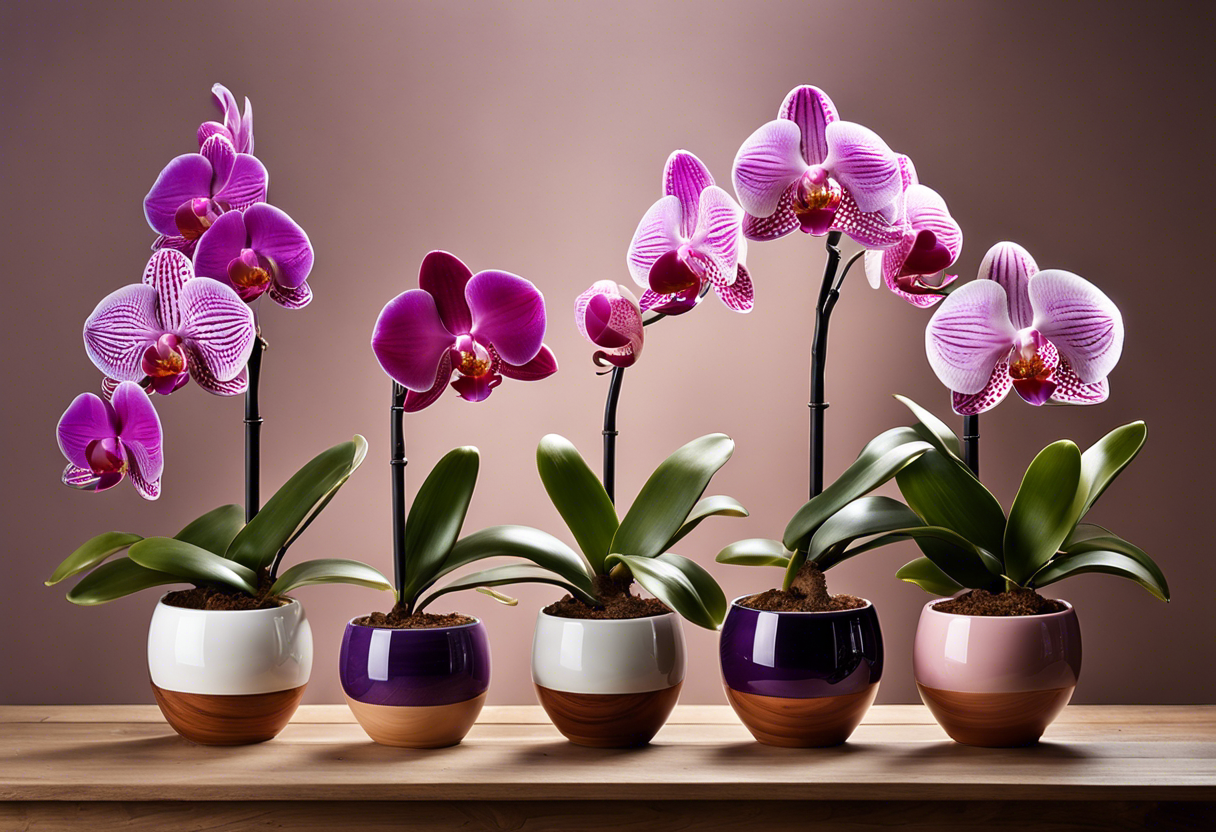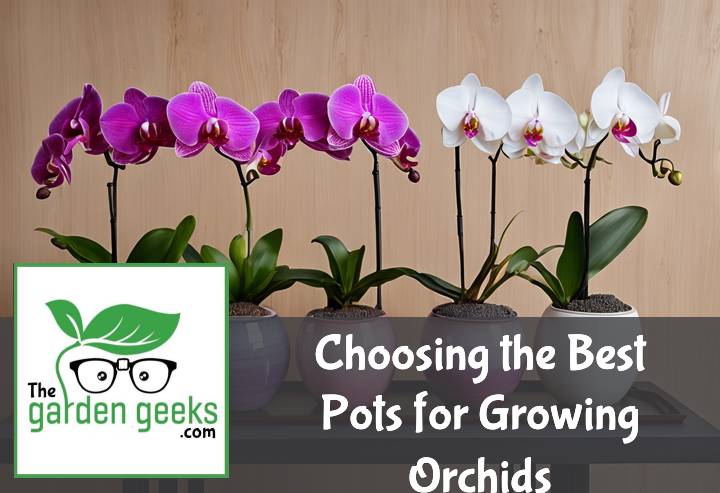Hello there, green thumbs and orchid enthusiasts! Ever wondered why your beautiful blooms aren’t thriving as they should? It could be because you’re not using the Best Pots for Growing Orchids. Yep, you heard it right! The pot matters just as much as the care you provide.
Choosing the ideal pot is an art, a science, and sometimes a bit of a guessing game. But don’t worry! We’re here to guide you through this process with some handy tips and examples. Keep reading about Choosing the Best Pots for Growing Orchids (with Examples).
Key Takeaways
- The best pots for growing orchids are those with good drainage, like terracotta or plastic pots with holes.
- Size is important; the pot should be just large enough to accommodate the orchid’s roots.
- Clear plastic pots allow you to monitor root health without disturbing the plant.
- Examples of suitable pots include the Mkono Plastic Orchid Pots, Meshpot Clear Plastic Orchid Pot, and Blue Sapphire Orchitop Carousel Orchid Pot.

Why Choosing the Right Pot for Orchids is Important
Choosing the right pot for your orchids isn’t just about aesthetics. It’s a crucial part of orchid care that significantly impacts their health and growth.
Understanding Orchid’s Unique Root System
Orchids are special, not just in their beauty but also in their root system. Unlike most plants, they have a unique root system that requires specific conditions to thrive. The roots need ample space to breathe and absorb nutrients effectively.
This peculiarity greatly influences the choice of pot for your orchid. A pot too small can restrict root growth, while one too large can lead to waterlogging. Understanding this aspect of orchid cultivation helps you make an informed decision when selecting the best pots for growing orchids.
The Role of Pots in Orchid Health and Growth
Pots play a significant role in maintaining the health and promoting the growth of your orchids. They provide a controlled environment where these delicate beauties can flourish under optimal conditions.
The right pot ensures good drainage, preventing water from stagnating around the roots – a common cause of root rot. It also provides enough room for roots to spread out comfortably, contributing to healthy orchid cultivation.
In essence, choosing the right pot is like providing your orchids with a cozy home where they can grow happily and healthily. So remember, when it comes to picking the best pots for growing orchids, it’s not just about looks—it’s about creating optimal growth conditions for your precious plants!
Types of Pots Suitable for Growing Orchids

When it comes to growing orchids, the pot you choose can make a big difference. Let’s dive into the world of orchid pots and explore some suitable pots for orchids.
Plastic Pots
Plastic pots, they’re like the unsung heroes of the orchid world. These bad boys are not only affordable but also great at retaining moisture. That’s right, folks! With plastic pots for orchids, you don’t have to worry about your precious plants drying out too quickly. Plus, they’re lightweight and easy to move around. So if you’re on a budget but still want the best pots for growing orchids, plastic might just be your new best friend.
Clay or Ceramic Pots
Now let’s talk about clay or ceramic pots. They’ve got this rustic charm that can really add a touch of elegance to your orchid display. But beauty aside, these clay pots for orchids are also pretty good at regulating temperature and allowing air circulation around the roots. However, they do tend to dry out faster than plastic ones and can be quite heavy. So while they might not be everyone’s cup of tea, they could be just what your orchids need if you live in a hot climate.
Glass or Crystal Clear Pots
Ever thought about using glass or crystal clear pots? Well, maybe you should! These transparent beauties allow light to reach your orchid’s roots, which is something most other pot types don’t offer. This extra light can help boost photosynthesis and promote healthier growth overall. So if you’re looking for an innovative way to give your orchids a little extra love, consider trying out some glass pots for orchids.
Basket Style Pots
Last but not least, we have basket style pots. These are perfect for those of you who are growing epiphytic orchids, also known as air orchids. These types of orchids love to cling onto tree branches in their natural habitat. So a basket style pot can mimic this environment by allowing the roots to hang freely. Plus, they provide excellent drainage and air circulation. So if you’re an epiphytic orchid enthusiast, these basket style pots for orchids might be just what you need!

Factors to Consider When Choosing a Pot for Orchids
Choosing the right pot for your orchids is like picking out their new home. It’s not just about looks, but also about functionality. Orchid pot selection is crucial as it can greatly impact the health and growth of your precious plants.
Size of the Pot
Now, let’s talk size. You might think bigger is better, but that’s not always the case with orchids. The ideal pot size for orchids depends on their type and age. A too-big pot can lead to over-watering and root rot, while a too-small one can stunt growth.
On the other hand, certain types of orchids prefer cozy quarters. So, it’s all about finding that Goldilocks zone – not too big, not too small, just right! That’s why understanding the impact of pot size on orchids is key in choosing the right size pot for orchids.
Drainage Capabilities
Next up: drainage. Orchids are drama queens when it comes to water – they need just enough but not too much. Hence, proper orchid pot drainage is vital to prevent waterlogging and promote healthy roots.
Common drainage issues in orchid pots include blocked holes or trays that hold excess water. To solve these problems, opt for pots with multiple drainage holes or use a well-draining substrate.
Material of the Pot
Material matters too! From clay to plastic and even glass – each has its pros and cons when used as orchid growing pots.
Clay pots are breathable but dry out quickly; plastic ones retain moisture but may lack ventilation; glass pots look stunning but can be tricky to manage moisture levels in. So choose wisely considering these factors when deciding on the best material for orchid pots.
Shape and Design
Last but not least, let’s consider shape and design. While it might seem purely aesthetic, the shape of an orchid pot can impact root development and overall plant health.
For instance, a shallow, wide pot is ideal for orchids with sprawling root systems. On the flip side, a tall, narrow pot suits those with deep roots. And of course, the design adds to the aesthetic appeal of orchid pots, making your green corner even more pleasing to the eye.
So there you have it! Remember these factors when choosing the best pots for growing orchids and watch your beauties thrive!
Examples of Best Pots for Different Types of Orchids
Choosing the right pot is a game-changer in your orchid care routine. It’s like picking a home that suits your lifestyle. Phalaenopsis, Dendrobium, and Cattleya orchids each have their unique needs. So, let’s dive into the world of orchid pots.
Best Pots for Phalaenopsis Orchids
Phalaenopsis orchids are quite the divas. They love to show off their roots! Hence, clear plastic pots work wonders for them. These allow you to monitor root health without disturbing the plant.
Size matters too! A snug pot encourages healthy root growth. But remember, it shouldn’t be too tight or too loose.
Drainage is another key aspect of Phalaenopsis orchid care. Look for pots with ample drainage holes to prevent waterlogging.
Best Pots for Dendrobium Orchids
Dendrobiums are more on the adventurous side. They prefer climbing up rather than spreading out. Tall pots are their best buddies!
Material-wise, clay or ceramic works well due to its porous nature. It provides excellent air circulation and prevents over-watering.
Remember, good drainage is essential in Dendrobium orchid care as well! So keep an eye out for those drainage holes when choosing the best pots for Dendrobium.
Best Pots for Cattleya Orchids
Cattleya orchids are somewhat middle-grounders in terms of pot preference. They don’t mind being a bit cramped but appreciate some room to grow.
When it comes to material, they’re not picky either! Plastic or clay – both work fine as long as there’s good drainage.
So whether you’re choosing plastic or clay, make sure it fits your Cattleya’s size and has enough drainage. That’s the secret to successful Cattleya orchid care!
How to Repot an Orchid into a New Pot
Repotting orchids is a crucial part of orchid care. It’s like moving your plant buddy into a new, comfy home. Let’s dive into the nitty-gritty of repotting orchids, from knowing when it’s time to move, prepping the new crib (a.k.a the pot), and finally executing the big move.
When to Repot Your Orchid
So how do you know when your leafy friend needs a change of scenery? Well, there are some telltale signs for repotting orchids. If you notice your orchid’s roots growing over the edge of its pot or if they’re starting to look a bit rotten and sad, it might be time for a change.
Also, keep an eye on your plant’s overall health. If it starts looking less than stellar despite proper care, it could be screaming for a new pot. Remember, timing is everything in orchid repotting.
Preparing the New Pot
Now onto preparing the new digs! First off, make sure you clean that pot good and proper. You wouldn’t want any nasty germs hitching a ride with your plant now, would you? So give that pot a good scrubbing before anything else.
Next up is choosing the right size for your orchid’s new home. This isn’t Goldilocks; too big or too small just won’t do! The right size pot for orchids should allow enough room for growth but not so much that your plant feels lost in space.
The Repotting Process
Alrighty then! Now we’re onto the actual moving day – repotting day! Here are some simple steps for repotting orchids without causing root damage.
Firstly, gently coax your plant out of its old pot. Be careful not to damage the roots during this process. It’s a bit like trying to get a stubborn cat out of a box, but with more finesse and less hissing.
Next, place your orchid in its new pot. Make sure it’s comfortable and secure before you start adding the growing medium. And voila! You’ve successfully repotted your orchid! Give yourself a pat on the back and maybe even a green thumb award!

To Wrap Up
Choosing the Best Pots for Growing Orchids is like finding the perfect pair of jeans – it’s all about the fit, breathability and style! Remember, your orchids are divas; they need their space but also crave attention.
So, don’t shy away from experimenting until you find that perfect pot that makes your orchids sing (or bloom)! Happy gardening!


